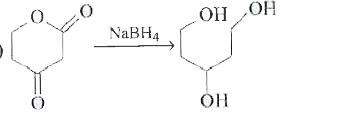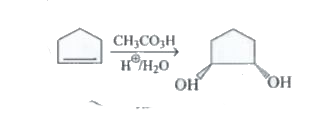Which of the following reaction(s) is/are correct?
a.
b.
c.
d.
The correct Answer is:A, D
To determine which of the given reactions is/are correct, we need to analyze each reaction step by step.
Step 1: Analyze Reaction A
- Given: An aldehyde group and a nitro group on a phenyl ring, with sodium borohydride (NaBH4) as the reagent.
- Expected Reaction: NaBH4 is a reducing agent that can reduce aldehydes to alcohols and nitro groups to amino groups.
- Conclusion: The aldehyde should be converted to an alcohol, and the nitro group should be converted to an amino group. If the reaction shows that the nitro group remains unchanged, then this option is incorrect.
Step 2: Analyze Reaction B
- Given: The same structure as Reaction A with NaBH4.
- Expected Reaction: As previously discussed, NaBH4 should reduce the aldehyde to an alcohol and the nitro group to an amino group.
- Conclusion: If the product shows both the aldehyde converted to an alcohol and the nitro group converted to an amino group, then this reaction is correct.
Step 3: Analyze Reaction C
- Given: A nitro group and a ketone group on a phenyl ring, with lithium aluminium hydride (LiAlH4) as the reagent.
- Expected Reaction: LiAlH4 is a strong reducing agent. It can reduce ketones to secondary alcohols and nitro groups to diazo compounds.
- Conclusion: If the product shows the ketone converted to a secondary alcohol and the nitro group converted to a diazo compound, then this reaction is correct. If the nitro group remains unchanged, then this option is incorrect.
Step 4: Analyze Reaction D
- Given: The same structure as Reaction C with LiAlH4.
- Expected Reaction: Similar to Reaction C, we expect the ketone to be reduced to a secondary alcohol and the nitro group to be converted to a diazo compound.
- Conclusion: If the product shows both transformations occurring, then this reaction is correct.
Final Conclusion
Based on the analysis:
- Reaction A is incorrect because the nitro group remains unchanged.
- Reaction B is correct as both functional groups are transformed as expected.
- Reaction C is incorrect if the nitro group does not change to a diazo compound.
- Reaction D is correct if both transformations occur.
Thus, the correct options are B and D.
---
- Given: An aldehyde group and a nitro group on a phenyl ring, with sodium borohydride (NaBH4) as the reagent.
- Expected Reaction: NaBH4 is a reducing agent that can reduce aldehydes to alcohols and nitro groups to amino groups.
- Conclusion: The aldehyde should be converted to an alcohol, and the nitro group should be converted to an amino group. If the reaction shows that the nitro group remains unchanged, then this option is incorrect.
- Given: The same structure as Reaction A with NaBH4.
- Expected Reaction: As previously discussed, NaBH4 should reduce the aldehyde to an alcohol and the nitro group to an amino group.
- Conclusion: If the product shows both the aldehyde converted to an alcohol and the nitro group converted to an amino group, then this reaction is correct.
- Given: A nitro group and a ketone group on a phenyl ring, with lithium aluminium hydride (LiAlH4) as the reagent.
- Expected Reaction: LiAlH4 is a strong reducing agent. It can reduce ketones to secondary alcohols and nitro groups to diazo compounds.
- Conclusion: If the product shows the ketone converted to a secondary alcohol and the nitro group converted to a diazo compound, then this reaction is correct. If the nitro group remains unchanged, then this option is incorrect.
- Given: The same structure as Reaction C with LiAlH4.
- Expected Reaction: Similar to Reaction C, we expect the ketone to be reduced to a secondary alcohol and the nitro group to be converted to a diazo compound.
- Conclusion: If the product shows both transformations occurring, then this reaction is correct.
Based on the analysis:
- Reaction A is incorrect because the nitro group remains unchanged.
- Reaction B is correct as both functional groups are transformed as expected.
- Reaction C is incorrect if the nitro group does not change to a diazo compound.
- Reaction D is correct if both transformations occur.
Topper's Solved these Questions
- REDUCTION AND OXIDATION REACTION OF ORGANIC COMPOUNDSBOOK - CENGAGE CHEMISTRY ENGLISHCHAPTER - REDUCTION AND OXIDATION REACTION OF ORGANIC COMPOUNDSEXERCISE - Exercise (Single Correct)
90 Videos
- REDUCTION AND OXIDATION REACTION OF ORGANIC COMPOUNDSBOOK - CENGAGE CHEMISTRY ENGLISHCHAPTER - REDUCTION AND OXIDATION REACTION OF ORGANIC COMPOUNDSEXERCISE - Exercise (Assertion And Reasoning)
10 Videos
- REDUCTION AND OXIDATION REACTION OF ORGANIC COMPOUNDSBOOK - CENGAGE CHEMISTRY ENGLISHCHAPTER - REDUCTION AND OXIDATION REACTION OF ORGANIC COMPOUNDSEXERCISE - Exercise (Linked Comprehension)
52 Videos
- QUALITATIVE INORGANIC SALT ANALYSISBOOK - CENGAGE CHEMISTRY ENGLISHCHAPTER - QUALITATIVE INORGANIC SALT ANALYSISEXERCISE - Viva Voce Questions And Part-C (Analysis Of Cations)
42 Videos
- SOLID STATEBOOK - CENGAGE CHEMISTRY ENGLISHCHAPTER - SOLID STATEEXERCISE - Ex 1.2 (Objective)
9 Videos
Similar Questions
Knowledge Check
Which of the following reactions are correct ?
A B
B C
C DCH3−C≡NLiAlH4−−−→CH3CH2NH2
DCH3−C≡NLiAlH4−−−→CH3CH2NH2Which of the following reactions are correct?
A B
B C
C D
D
Which of the following reactions are correct?
A B
B CCH3−O∣∣C−ClPhMgBr−−−−−→H⊕/H2OCH3−O∣∣C−PhDPhMgBrCO2−−−−−→H⊕/H2OPh−O∣∣C−OH
CCH3−O∣∣C−ClPhMgBr−−−−−→H⊕/H2OCH3−O∣∣C−PhDPhMgBrCO2−−−−−→H⊕/H2OPh−O∣∣C−OH
Which of the following reaction is/are correct?
View SolutionWhich of the following reaction(s) is/are wrong?
View SolutionWhich of the following statement(s) is/are correct?
View SolutionWhich of the following statement(s) is/are correct?
View SolutionWhich of the following reactions is not correct ?
View Solution
